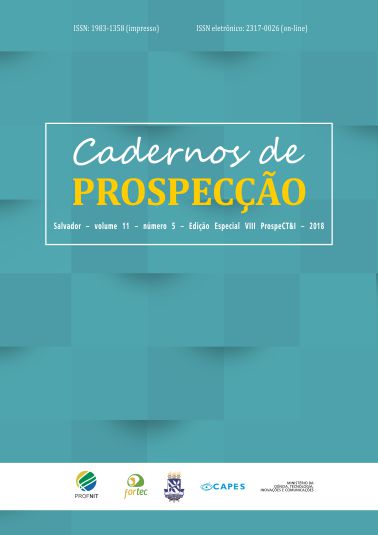Patent Technological Prospecting Related to the Preservation of Animals and their Parts
DOI:
https://doi.org/10.9771/cp.v11i5.27210Keywords:
Patent, Preservation, Technological Prospecting.Abstract
The evolution of human knowledge, concerning the study of terrestrial fauna, requires actions, involving animal experimentation, triggering the needs of searching for innovative technologies for their preservation. This article aims to map the main applications for patents in the world, related to the preservation of animals and their parts and to identify which technologies it involves, preservation of the museum collection. Methodologically, were combined research in the Portal of CAPES Periodicals and patenting in the Espacenet, between the period 2000 to 2018. The results showed that the largest depositors are the United States (US), China (CN) and directly in WIPO (World Intellectual Property Organization). The technologies involved in the preservation of animals and their parts presented the following cooperative patent classifications: C12N1/14, A01N1/02, A61K38/00, A01N3/00, A61K38/45, A23L3/3463 and A61K31 / 4178, involving preservation of museum collection: A01N1 / 00 and A01N1 / 02. It was concluded that this is a broad subject, with vast field for technological development, but still little explored in the world.
Downloads
References
ARANDA, A. T. Coleções Biológicas: conceitos básicos, curadoria e gestão, interface com a biodiversidade e saúde pública. In: SIMPÓSIO SOBRE A BIODIVERSIDADE DA MATA
ATL NTICA (SIMBIOMA), 3., Santa Tereza, 2014. Anais... Santa Tereza, ES: SIMBIOMA, 2014. p. 45.
BELO, C. A. V. F. Avaliação da exposição profissional ao formaldeído e xileno no serviço de anatomia patológica dos Hospitais da Universidade de Coimbra. 120 f. 2011. Dissertação (Mestrado em Saúde Ocupacional) – Faculdade de Medicina da Universidade de Coimbra, [S.l.], 2011. p. 99
CARLAN, C. U. Os Museus e o Patrimônio Histórico: uma relação complexa Rio de Janeiro. Revista História, São Paulo, v. 27, n. 2, p. 442-451, 2000.
CASSARES, N. C. Como fazer conservação preventiva em arquivos e bibliotecas. São Paulo: Arquivo do Estado e Imprensa Oficial, 2000. v. 5.
EUROPEAN PATENT CONVENTION (EPC). Convention on the Grant of European Patents. 1978. Disponível em: <https://treaties.un.org/doc/Publication/UNTS/Volume%201065/volume-1065-I-16208-English.pdf>. Acesso em: 26 dez. 2018.
INSTITUTO BRASILEIRO DO MEIO AMBIENTE E DOS RECURSOS NATURAIS RENOVÁVEIS (IBAMA). Instrução Normativa n. 154, de 1º de março de 2007. Disponível em: <http://www.fzb.rs.gov.br/upload/1366827462_IN_154_coleta.pdf>. Acesso em: 10 set. 2018.
INSTITUTO ESTADUAL DE EDUCAÇÃO, CIÊNCIA E TECNOLOGIA DO MARANHÃO (IEMA). Instrução Normativa n. 001, de 2 de abril de 2016. Disponível em: <https://iema.es.gov.br/Search?q=Instru%C3%A7%C3%A3o+Normativa+n%C2%BA+001+de+2016&culture=pt-BR>. Acesso em: 10 set. 2018.
MARTINS, U. R. A coleção taxonômica. In: PAPAVERO, Nelson. (Org.). Fundamentos práticos da taxonomia zoológica: coleções, bibliografia, nomenclatura. São Paulo: Universidade Estadual Paulista, 1994. p. 20-39.
POSSOBON, R. Bomba Peristáltica. 2016. Disponível em: <https://www.ifi.unicamp.br/~lunazzi/F530_F590_F690_F809_F895/F530_F590_F690_F895/F530_F590_F690_2016_sem2/RenataP-Varlei-RF2_F530.pdf>. Acesso em: 26 set. 2018.
PROGRAMA DE PESQUISA EM BIODIVERSIDADE (PPBIO). Museu Paraense Emílio Goeldi. Curadoria. 2011. Disponível em: <http://ppbio.museu-goeldi.br/sites/default/files/Treinamento/specify/Curadoria.pdf>. Acesso em: 14 set. 2018.
RANGEL, M. Os museus de história natural como espaço de construção do saber. Hist. Cienc. Saúde Manguinhos, Rio de Janeiro, v. 17, n. 3, 2010.
SANJAD, N.; BRANDÃO, C. R. F. A exposição como processo comunicativo na política curatorial. In: Museus: curadorias, exposições, ação educativa. Belo Horizonte: Secretaria de Estado de Cultura de Minas Gerais, Superintendência de Museus, 2008. p. 27-35.
INGENITO, L. F. S. Curadoria de Coleções Zoológicas. In: SIMPÓSIO SOBRE A BIODIVERSIDADE DA MATA ATL NTICA (SIMBIOMA), 3., Santa Tereza, ES, 2014. Minicurso. Santa Tereza, ES: SIMBIOMA, 2014. Disponível em: <https://www.researchgate.net/publication/281637488_Curadoria_de_Colecoes_Zoologicas>. Acesso em: 6 jul. 2018.
SERAFINI, M. R. et al. Mapeamento de tecnologias patenteáveis com o uso da hecogenina. Revista Geintec, v. 2, n. 5, p. 427-435, 2012.
SILVA, C. A. V. da. Farmacologia clínica: medicamentos e seu uso na clínica médica. 2013. Disponível em: <https://pt.scribd.com/document/178876442/1-LIVRO-EM-REVISAO-FINAL-24-10-2013-URM-Farmacologia-Clinica-Medicamentos-PRIMEIRA-PARTE>. Acesso: em 25 set. 2018.
SOARES, Caroline Santos. Área de risco ou área de rico: teorias sobre política, direito e respeito na Cidade Estrutural. 2013. 192 f. Tese (Doutorado em Sociologia) – Departamento de Sociologia, Universidade de Brasília, Brasília, DF, 2013.
SOLAR, M.G.; LANDIM, M.S. O silêncio dos inocentes: o papel dos animais em narrativas expositivas. Anais do Museu Paulista, São Paulo, v. 25, n. 2, p. 269-289, 2017.
SOUZA JÚNIOR, E. M. S. et al. Incrustação de insetos em resina para coleções didáticas. Holos, [S.l.], v. 5, p.151-157, 2017.
SPINELLI, J. J. A conservação de acervos bibliográficos & documentais. Rio de Janeiro: Fundação Biblioteca Nacional, Dep. de Processos Técnicos, 1997, p. 90.
TAFFAREL, C. D. Museus escolares: a utilização de técnicas de taxidermia como auxílio no ensino da educação ambiental. Revista Monografias Ambientais, [S.l.], v. 10, n. 10, p. 2.128 – 2.133. 2013. Disponível em: <https://periodicos.ufsm.br/remoa/article/view/6312>. Acesso em: 26 dez. 2018. doi:http://dx.doi.org/10.5902/223613086312.
Downloads
Published
How to Cite
Issue
Section
License
Copyright (c) 2018 Cadernos de Prospecção

This work is licensed under a Creative Commons Attribution-NonCommercial 4.0 International License.
O autor declara que: - Todos os autores foram nomeados. - Está submetendo o manuscrito com o consentimento dos outros autores. - Caso o trabalho submetido tiver sido contratado por algum empregador, tem o consentimento do referido empregador. - Os autores estão cientes de que é condição de publicação que os manuscritos submetidos a esta revista não tenham sido publicados anteriormente e não sejam submetidos ou publicados simultaneamente em outro periódico sem prévia autorização do Conselho Editorial. - Os autores concordam que o seu artigo ou parte dele possa ser distribuído e/ou reproduzido por qualquer forma, incluindo traduções, desde que sejam citados de modo completo esta revista e os autores do manuscrito. - Revista Cadernos de Prospecção está licenciado com uma Licença Creative Commons Attribution 4.0. Esta licença permite que outros remixem, adaptem e criem a partir do seu trabalho para fins não comerciais, e embora os novos trabalhos tenham de lhe atribuir o devido crédito e não possam ser usados para fins comerciais, os usuários não têm de licenciar esses trabalhos derivados sob os mesmos termos.
Este obra está licenciado com uma Licença Creative Commons Atribuição 4.0 Internacional.





